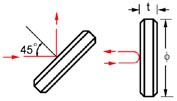| |
|
|
 |
|
 |
|
Metallic Mirror
Metallic Mirrors descript a
good mixture of performance and value. These broadband coatings are
relatively insensitive to wavelength, angle of incidence, and
polarization. However high-energy levels should be avoided. Such metallic HR mirror are widely use in projection optics systems, imaging optics systems, Optical Measurement System, sensors or laser measurement systems.
Protected Aluminum For general broadband use, a protected
aluminum coating offers the best option. A SiO2 coating is used to
protect the delicate aluminum coating, making it suitable for
laboratory and industrial use. This coating gives a reflectivity
that most closely matches the reflection of a bare aluminum coating:
Ravg>87% @400-1200nm. |

|
General Specifications |
Parameter |
Commercial grade |
Substrate Material |
BK7 grade A optical glass, Fused Silica
etc. |
Diameter Tolerance |
+0/-0.15mm |
Thickness Tolerance |
+/-0.2mm |
Clear Aperture |
>Central 85% of diameter |
Surface Quality |
60-40 S/D |
Parallelism |
< 1 acr minute |
Wavefront Distortion |
¦Ë/4 @632.8nm , Up to ¦Ë/10 @632.8nm |
Chamfer |
0.25mm x 45¡ã |
Coating |
Al Protect, Ag Protect, Au Protect, Al
VIS Enhanced |
BK7
Plano-Flat Metallic Mirror Standard Products:
Part No. |
Coating |
Flatness |
f(mm) |
t(mm) |
MPF0101 |
Al Protect |
¦Ë/4 |
25.4 |
3.0 |
MPF0102 |
Al Protect |
¦Ë/10 |
25.4 |
6.35 |
MPF0201 |
Al VIS Enhanced |
¦Ë/4 |
25.4 |
3.0 |
MPF0202 |
Al VIS Enhanced |
¦Ë/10 |
25.4 |
6.35 |
MPF0301 |
Ag Protect |
¦Ë/4 |
25.4 |
3.0 |
MPF0302 |
Ag Protect |
¦Ë/10 |
25.4 |
6.35 |
MPF0401 |
Au Protect |
¦Ë/4 |
25.0 |
3.0 |
MPF0402 |
Au Protect |
¦Ë/10 |
25.4 |
6.35 |
| Note: Plano-Concave Metallic Mirror,Plano-Concave
Cylindrical Metallic Mirror and other type Mirrors are unpon
requirements. The general tolerance specifications above provide a
guideline regarding manufacturing capabilities for optics ranging in
size from 2-300mm. The manufacturing limits are not absolute;
tighter tolerances may be possible. Part specific tolerances may
vary depending on component size, shape, and/or
material. |
|
|
|
|
|